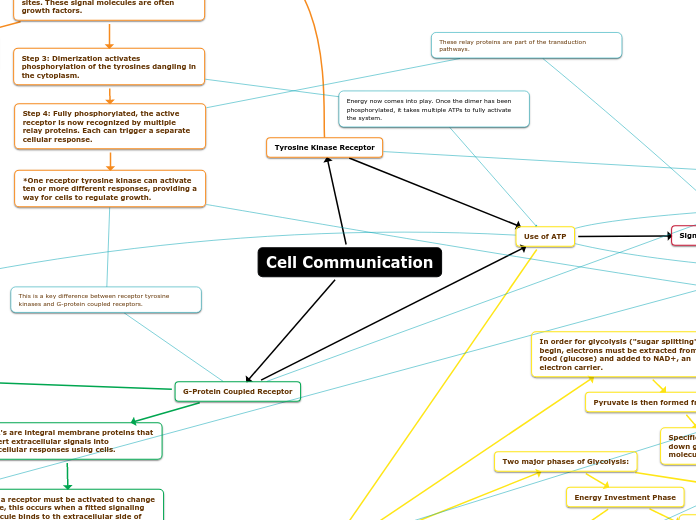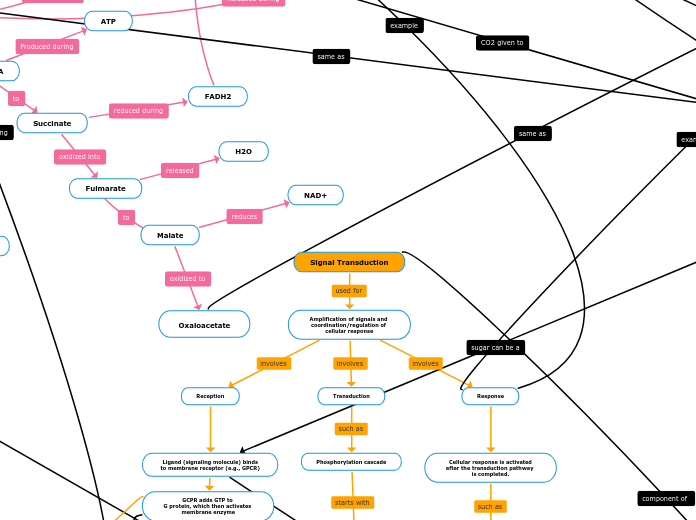Pyruvate oxidation
The pyruvate that was previously formed is oxidized (in the presence of O2).
When the pyruvate is oxidized, it loses electrons which is then transferred to NAD+ to form the NADH we see later
Acetyl CoA is then formed
Enters the citric acid cycle (Kreb's cycle) and results in the creation of more electron carriers, NADH and FADH2
This occurs inside of the mitochondria, as the pyruvate enters
Krebs Cycle
Mitochondrial matrix
Oxidative Phosphorylation
require oxygen
consists of:
Electron Transport Chain (ETC)
creates a concentration gradient of H+
O2 is final electron receiver
Chemiosmosis
26-28 net ATP per glucose
per 1 acetyl CoA
Forms 1 FADH2
electron carriers used in:
Forms 3 NADH
Forms 1 ATP
releases 1 CO2
This is a key difference between receptor tyrosine kinases and G-protein coupled receptors.
These relay proteins are part of the transduction pathways.
Energy now comes into play. Once the dimer has been phosphorylated, it takes multiple ATPs to fully activate the system.
Cell Communication
G-Protein Coupled Receptor
cAMP as a second messenger in signaling pathway of a G protein
First Step: GCPR is activated with a first messenger bind.
Second Step: The now activated GCPR binds to the G protein that gets bounded by GTP, leading to an activated G protein.
Third Step: The activated G protein and GTP bind to adenylyl cyclase. GTP is hydrolyzed causing adenylyl cyclase to be activated.
Fourth Step: Activated adenylyl cyclase changes ATP to cAMP.
Fifth Step: The second messenger cAMP activates another protein that causes cellular responses.
GPCR's are integral membrane proteins that convert extracellular signals into intracellular responses using cells.
First a receptor must be activated to change shape, this occurs when a fitted signaling molecule binds to th extracellular side of the receptor.
The cytoplasmic side then binds to activate a G protein, this activated G protein has a GTP molecule carried.
The now activated G protein leaves the receptor to diffuse along the membrane to then bind to an enzyme that causes a change in this enzymes shape and activity. This activation leads to the next step in the process of causing cellular responses.
The binding of signal molecules can be undone. The changes made through activation changes for GPCR, G proteins, and enzymes are not permanent and can be reused.
Use of ATP
Signal Transduction
Signal transduction is the process of transferring an external signal to the interior of the cell. The process can be described in three steps.
Reception
Transduction
The amplification effect
In most cases of signal transduction, there are multiple different signals being communicated at the same time. This happens when one activation produces the means for multiple other activations.
If each activation produces multiple activations, each new activation will also produce more activations. This leads to an exponential growth of activations, thus amplifying the original signal.
Response
At the end of the transduction pathway, when the signal finally reaches its destination, the signal triggers a cellular response.
Different signals and different pathways trigger many different responses. These responses can do things like regulate gene expression, regulate the activity of other proteins in the cell, or other cell activities.
Transduction begins when the signal molecule changes the receptor in some way, activating it. Transduction is usually a series of processes that relay the initial signal to many molecules in a pathway.
This process is usually in the form of a phosphorylation cascade. A phosphorylation cascade is a sequence of signaling events where one enzyme phosphorylates another in a long chain. Each time an enzyme is phosphorylated, it uses ATP to transfer its signal.
When the protein is activated by ATP, it passes its signal to the next protein kinase in the chain. This process of taking the signal and transferring it to the next protein in the chain with ATP continues over and over until it reaches its final destination
After the signal is transferred, it is important for the signal to stop being transferred. This happens through the removal of the phosphate from the attached protein. This is called dephosphorylation, and it essentially deactivates the protein, turning it off.
The protein kinase takes a phosphate group from ATP, activating it. The ATP turns into ADP. In a long chain, there is a need for an abundance of ATP to give energy to each signal transfer.
This is the process where a signal molecule is received by a receptor protein. Receptors can be intracellular or membrane receptors. Tyrosine Kinase receptors and G-Protein Coupled receptors are examples of membrane receptors because when they receive a signal on the outside of the cell, they respond with a process that occurs inside the cell.
After the signal molecule activates the receptor, the receptor begins a series of steps that lead to transduction.
When the receptor is done transferring the signal to the next series of steps, it needs a way to stop sending the signal. This is done by deactivating the protein by removing the molecule that's powering it. Like turning GTP to GDP or ATP to ADP.
Glycolysis
This occurs in the cytoplasm outside of the mitochondria
Two major phases of Glycolysis:
Energy Payoff Phase
Step 6 (continuing from step 5): Two sequential reactions- G3P is oxidized by the transfer of electrons to NAD+, which forms NADH. Then using energy from this exergonic reaction, a phosphate group is attached to the oxidized substrate, making a high-energy product.
Step 7: The phosphate group is transferred to ADP in another exergonic reaction. The carbonyl group of G3P has been oxidized to the carboxyl group --COO- of an organic acid of 3-phosphoglycerate.
Step 8: The enzyme resulting from the phosphoglyceromutase relocates the remaining phosphate group
Step 9: Enolase causes a double bond to form in the substrate by extracting a water molecule which yields PEP
Step 10: The phosphate group is transferred from PEP to ADP, which forms pyruvate
Now we are using two molecules of G3P, so each product will be doubled
More ATP is made in the last 5 steps than in the first one, therefore being called the energy payoff phase
Energy Investment Phase
*Note- these 5 steps use ATP (none is made), hence referred to as the energy investment phase*
Step 1: involves addition of phosphate from ATP to Glucose to form glucose 6-phosphate using the enzyme Hexokinase
Step 2: converts this to Fructose 6-phosphate
Step 3: *very important* uses the enzyme PFK to convert Fructose 6-phosphate to Fructose 1,6-biphosphate
Step 4: Aldolase cleaves this sugar molecule into two different three-carbon sugars
Step 5: The 6 carbon sugar splits into two molecules of 3 carbon each form DHAP and G3P. Eventually DHAP converts into G3P, so we have two molecules of G3P formed from one molecule of glucose
In order for glycolysis ("sugar splitting") to begin, electrons must be extracted from food (glucose) and added to NAD+, an electron carrier.
Pyruvate is then formed from the glucose
Specifically breaks down glucose into two molecules of pyruvate
Tyrosine Kinase Receptor
Step 1: Receptor tyrosine kinases start out as inactive monomers, each having a ligand binding site.
Step 2: Monomers combine to make dimers when signal molecules bond with receptor sites. These signal molecules are often growth factors.
Many cancers are caused by mutated tyrosine receptors that activate without a signal molecule.
Step 3: Dimerization activates phosphorylation of the tyrosines dangling in the cytoplasm.
Step 4: Fully phosphorylated, the active receptor is now recognized by multiple relay proteins. Each can trigger a separate cellular response.
*One receptor tyrosine kinase can activate ten or more different responses, providing a way for cells to regulate growth.









